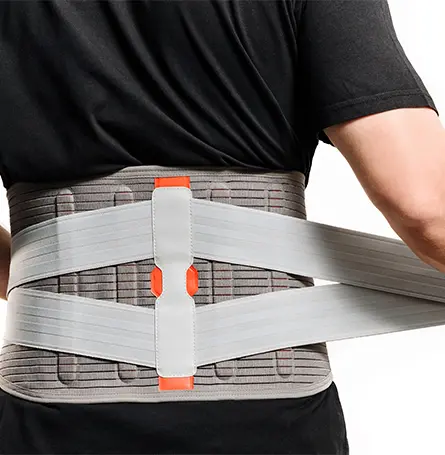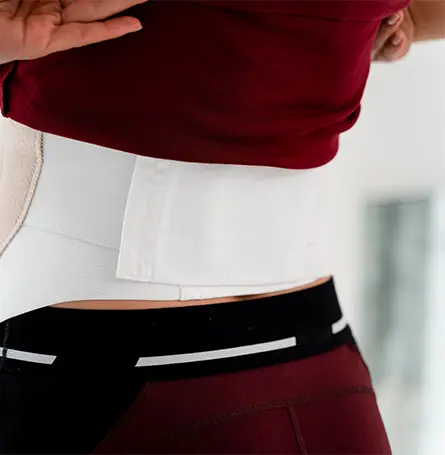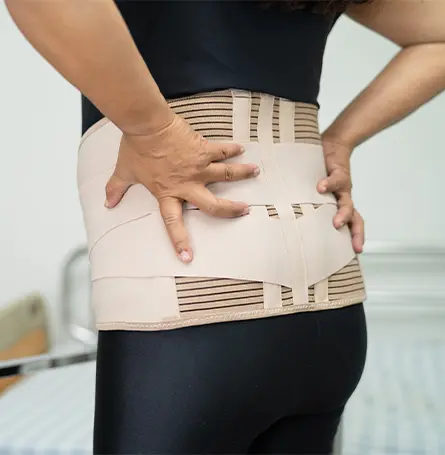What is a back support belt?

As the name would suggest, a back support belt is a belt that you wear around your hips or lower back that offers firm support to your spine and minimises movement. And, in theory, this can help alleviate back pain in a few ways.
For one, by restricting movement, you're more likely to maintain correct posture and allow any present injuries to heal naturally. And by avoiding poor posture, you're also less likely to experience further back injuries.
Secondly, by supporting your lumbar spine, you're less likely to injure yourself while lifting heavier objects. And this is theoretically very important for warehouse workers and people who spend the majority of their time carrying heavier objects.
Thirdly, some back belts also have heating elements. And while heat isn't the best at dealing with acute pain, it can help relieve pain in those suffering from chronic pain, old injuries, or muscle tension.
However, all of this is just on paper.
Do back support belts actually work?
So, does wearing a back support belt actually help in any meaningful way? Well, it's inconclusive. In one study, 28 workers were observed while wearing flexible lumbar supports and no difference was observed between their group and the placebo group.
So, while people wearing these kinds of support belts often feel like they are maintaining a healthy posture and keeping their backs safe, the data doesn't back it up.
On the other hand, this study took a look at lifting belts and did see notable differences when the subjects were going for heavier lifts. While this doesn't touch on whether the belt can relieve pressure, it does showcase that it can support the lumbar region and thus increase output during strenuous activities.
But even claims like these ones are disputed by NIOSH when put in the context of workers' safety – which is a much wider audience than just lifters. To be precise, they don't deny the effectiveness of support belts but rather point out that studies in this field have failed to offer conclusive proof.
With all of that being said, these kinds of studies mostly focused on “lighter” belts. So, let's go over all of the types of support belts and see whether some are more useful than others.
Types of back support belts
While things don't seem to be going really well for back support belts so far, that's because we've mostly focused on flexible, everyday support belts. However, sometimes fixed support can be more adept at dealing with lumbar pain than a belt offering gentle and flexible support.
And this is the main distinguishing factor between the two types of support belt. So, we're going to go over both types and explain how they can or can't help, as both types can be called support belts or back braces, often leading to confusion.
Flexible support belts

For most people, when they think of back support belts, they're thinking about the flexible support kind. These belts usually feature elastic materials that tightly squeeze your hips and/or abdomen, offering a bit of additional support.
These types of back supports usually limit your movement but still offer a bit of flexibility. For example, while you can still bend over, your fingers usually don't go past your knees.
So, in this sense, they can help keep you from injuring yourself if you have an already existing minor injury.
They can also somewhat help with back posture but won't fully prevent you from slouching. But it can be argued that this is more due to having a constant reminder to stand up straight than it is the direct consequence of the belt.
Lastly, since these belts are usually quite tight, there is an element of heat retention as well. And this generated heat can slightly help with conditions such as muscle spasms, although a heat pack would likely be more effective.
Plus, since these belts have adjustable straps, they're not always going to be so tight that they generate excess heat.
Semi-rigid and rigid back braces
A rigid back brace is usually used after surgeries or serious injuries to help patients properly recover. And, as the name would imply, they are far more rigid than the previous support belts, often completely limiting your ability to bend over or curve your spine.
These belts also offer a lot more added support, taking the pressure off your joints and spine, which can help with things such as a herniated disc or a sacroiliac joint injury. And there are studies showcasing a lower disability and pain score with these kinds of braces.
However, it's worth pointing out that these kinds of back braces, especially the rigid ones, aren't meant for everyday people who suffer from some back pain. Rather, doctors will usually advise having these braces done if you've experienced an injury or have some underlying medical condition causing your lower back pain.
What are the downsides to wearing a support belt?

While we can't say that wearing a back support belt will definitely help you, some might still want a back support belt for work if they spend a lot of time lifting heavier objects. Or just to keep their posture healthy.
However, this begs the question, are there any downsides to wearing these belts? Or is a lumbar support belt something that can either help or do nothing at all? Well, there can be some downsides. However, how present or disruptive they are will vary greatly from person to person.
- Skin irritation – If you have very sensitive skin, the firm support of a belt might be a bit too firm. After all, to get support for back pain relief, the belt has to squeeze your torso quite a bit. So, some people might experience skin irritation as they move around.
- Stomach issues – On a similar note, if the belt goes over your lower abdomen, you might experience certain stomach issues. This is especially true for people who are often bloated.
- Muscle atrophy – To get spine support, your muscles also need to be “held tight”. And since your movement is limited, those muscles can begin to lose some of their volume. This process is called muscle atrophy and can cause other issues later on as weaker back muscles mean even less back support when you take the belt off.
Other options for dealing with lower back pain
As you can see, support belts aren't 100% backed by doctors – at least not for everyday use. So, if you need added lower back support, you might want to consider other options as well. Of course, you can still wear a support belt if you don't believe any of the potential side effects are likely to take hold.
And even if you don't have any back pain at the moment, these are just good practices to keep your back healthy in the long run. So, we'd definitely advise implementing all of them if you can.
Getting an appropriate mattress
A not-so-fun fact is that a bad mattress can cause back pain. And this is especially present when it comes to lower back pain. This is because if a mattress is too soft or too firm for your sleeping position and weight, your hips can be left in an unhealthy position. And since you don't move all that much during the night, this puts a lot of pressure on your lower back.
In this sense, getting a sciatica back support belt can be just as helpful as getting a good mattress for sciatica. And while we can't get into all the details here, since it's quite a lengthy process, you can read our guide on choosing the perfect mattress to see whether your current mattress is causing back pain.
Exercise (if possible)
When we talked about muscle atrophy, we mentioned that weak back muscles offer less back support when not wearing a belt. You can also use this same principle in the other direction by working your back muscles and adding more spine support that way.
Plus, if you work out with proper form, you'll be less likely to injure yourself when picking something off the ground. And if the gym isn't your speed or you're forbidden from lifting weights, try deep stretches and yoga!
Even a short stretching routine in the morning can make your back more resilient and help you out in the long run.
Work on your posture
While it can certainly help, an orthopaedic belt for back pain isn't necessary to have proper posture. And while we do acknowledge that it's easier said than done, you can learn to sit and stand straight if you put your mind to it.
There are also plenty of apps that will remind you throughout the day to straighten your back, roll back your shoulders, and keep your limbs at a 90-degree angle. And, for some, even this is enough to both relieve pain and stop future back pain from manifesting.

Conclusion
All in all, is getting a back support belt the ultimate way to never have lower back pain again? Not exactly. It might help some and it might not help others. And in some cases, it might even do more harm than good.
However, if you get a thumbs up from your doctor, they're likely to offer at least some pain relief. And when combined with a good mattress and even better habits, you should be able to keep lower back pain to a minimum.













There are no comments yet
"*" indicates required fields